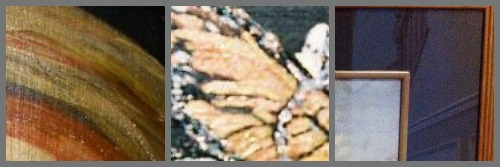by Carolyn Edlund
I recently spoke with my friend Ashwin Muthiah about ways to improve online sales. He works with artists every day to sell their work. He shared some tips to help you avoid mistakes and increase customer engagement.

Carolyn Edlund, founder of Artsy Shark, and Ashwin Muthiah
Carolyn: Ashwin, I know you see plenty of artwork for sale online, and you have great ideas for strategies on how to be successful there. What are some of the biggest mistakes you see that make you cringe?
Ashwin: Well, that’s true, there are some basic problems that are easy to spot, and that artists can avoid with a little planning. One of the most important is presentation, because as visual artists, it’s all about the image.
Carolyn: Absolutely! Poor photography of artwork is one of my pet peeves, too. I can’t tell you how many photos of art I’ve seen that are blurry, have glare, or where a 2D painting is not square (keystoned) with the camera angle. I’ve even seen artwork photographed outside – once with a highway in the background. Ouch!
Ashwin: (laughs) Yes, and this is easily remedied. Take an honest look at the photos of your artwork. Are they really excellent? Because they should be. Use a professional photographer or learn how to shoot really great images yourself. I’d also like to add that when you present your artwork online, you must have the image large enough for the viewer to see. The website should enable images to enlarge so that the shopper can get a very clear look and imagine owning your art. No one is going to pull out their wallet if they can’t see what they’re buying.

Examples of photo mistakes: out of focus, glare, reflections and tilted images.
Carolyn: And people can’t make a buying decision if they don’t know the price of your work either. That’s another mistake that I see people making when they show their artwork online. Is your work for sale? Then you have to share the price with the visitor. Without this important information, they will just move on and buy art somewhere else.
Ashwin: There are a few circumstances where you may not list prices, for example if artwork is sold or that piece is actually not for sale. Or, if you sell through a gallery and have an agreement not to list prices online. But otherwise, it only makes sense. Website visitors who love your art will immediately know if it is within their price range. Your goal is to either make the sale, or start a conversation where they will want to know more.
Carolyn: If those shoppers don’t buy or rent your work at the time of their first visit, you must stay in touch with them, because it can take 7-10 “touches” to be remembered by your prospective customer. Collecting their email address and staying in touch through an email marketing campaign is a proven strategy that closes more sales.
Ashwin: Yes. You worked hard to get people to visit your art website, right? Well, it’s the follow up that will make your work memorable and draw in that important customer engagement that you want. Keep sharing your art and your portfolio with people who are interested. Offer them an opportunity to visit your site again, and to understand your inspiration and your process.
Carolyn: That type of understanding happens when you share lots of information with them. I find that quite often artists are not giving shoppers enough to create a comfort level for buying.
Ashwin: Adequate information is such an important factor in actually closing the sale. I’m a big proponent of artists telling their stories. What inspires you? What is amazing about your technique? You as an artist are really fascinating to other people. Collectors will also tell your story when other people see the artwork they have bought from you. It becomes an intrinsic part of your artwork and making the sale.
Carolyn: To summarize, using great photos, pricing your work, sharing lots of information and details and gathering emails for further follow up will increase any artist’s potential.
Ashwin: Yes. It’s true that every website is a work in progress, but I would recommend that each artist take a hard look at their current online presence. Check off the list to make sure that you are using these strategies to increase the chances of selling your art.


Hi, and thank you for the article. The question of pricing on the website has confounded me for many months. I used to put prices on my website, then I started getting my work into galleries and realized my website prices were not comparable to the retail prices the galleries were charging, so I raised the online prices. But then people who had been buying my work thought the new pricing was too rich for their blood, so I offered newsletter subscribers 20% off of purchases, which sweetened the pot. Then a curator and dealer told me unequivocally to “take your prices off of your site” because it will kill gallery interest. So, I took the prices off of my website. If I could just sell directly to clients that would be my preferred state, but despite having a newsletter and many online promotion outlets (instagram, pinterest, tumblr, Facebook etcetc) I do not have enough newsletter sign ups to forgo brick and mortar venues. What’s a girl to do?
Sarah, Here’s what I tell artists about this confusing subject, and I hope it will be useful for you: ALWAYS be consistent with your prices. Never undercut your galleries or wholesale customers. You ran into problems when your prices started changing depending on the venue. You should know your basic pricing formula to begin with and what the retail price should be. Then stick with it.
And, ALWAYS honor your contracts. If you have a gallery with whom you have a good relationship, and if they are selling well for you, do not price your work on your website if it against their policies or advice, in the interest of preserving that relationship.
This article came at the perfect time for me, I’m in the process of ordering a Umbrella lighting kit for my studio. Thank-you so much for this article, great advice on how to take the best shots of ones work!
Good luck with that portfolio Linda! You can get some further photography tips right here http://www.artsyshark.com/2015/04/23/mistakes-photographing-art/
Here is a very good article on photographing your art. Some good tips.
http://www.lightspacetime.com/art-blog/tips-on-photographing-your-art-the-right-way/
Thanks for the link, Lee. John Math at Light Space Time Online Gallery does a great job educating artists about presentation – and Artsy Shark has several guest posts by John to help our readers, too.